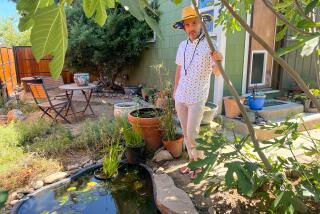The Old Gazebo Gambit Doesnât Fool Him for Minute
There was an ingenious hobo trick that was popular during the Great Depression (the one in the â30s) that ought to serve as a warning to anyone who has ever considered just a little bit of plastic surgery: the rock soup routine. The hungry rail-rider would show up on someoneâs back porch and ask the lady of the house if he might give her the recipe for rock soup.
If the unsuspecting woman bit, heâd ask for a rock and a pot of water. Into the water would go the rock and the water would be brought to a simmering boil.
âNeeds a little something,â the hobo would say. âMaybe a carrot.â
You can see this coming. Inside of an hour, the pot would be filled with a richly seasoned beef-and-vegetable stew, each ingredient wheedled one by one--and a rock. The hobo would be happily fed and the woman would be pleased, if a bit bewildered, to have a new recipe.
If you folks at the Bradford House Foundation just read that, donât get the wrong idea; Iâm not trying to tell you that youâve just been had. Still, that little gazebo project that the environmental design class at Cal State Fullerton took on for you is starting to look a lot like a hoboâs rock.
Fortunately, this particular project is benign, educational, and it isnât going to cost the foundation any money, at least not yet.
Hereâs the deal: The Bradford House, a beautifully preserved Victorian-era house in Placentia that is on the state Historical Registry and is often used for weddings, is in need of a gazebo.
The Placentia Founders Society, which administers the house, wants a covered facility for outdoor wedding ceremonies. Enter Bryan Cantley, an assistant professor of environmental design at Cal State Fullerton. He had, he said, been trying to ease his design students away from the purely technical and into the realm of more conceptual and artistic designs--in landscapes, structures and interiors.
In short, he wanted them to go a little crazy.
The gazebo project, he said, seemed perfect. In a mock exercise that had the added attraction of also being an inter-class design competition, each student was assigned to prepare plans and a model of not only a gazebo for the Bradford House, but an enclosed garden, a satellite general purpose room, a reception area, furnishings, signage, noise screens, a water feature and parking.
And one more thing: the students were given carte blanche to reorganize the entire park, all 2.5 acres of it, in any way they wanted.
âBy all means,â Cantley wrote in his instructions, âTAKE CHANCES!!!â
And the students dutifully did. Conservatism, apparently, was considered to be no virtue. For example:
* Student Gary Hunt assembled a model of the grounds--and the required design elements--as if the grounds were a large archeological dig. The different levels of cuts in the ground led to the gazebo structure.
* Joan Decker designed the grounds on an ancient Egyptian theme, complete with an oasis, columns of palm trees and a gazebo intended to look like an Egyptian temple.
* Pollyanna Nordstrandâs water design element dominated her model: a long, thin waterway beneath the existing line of tall palms. It was, she said, intended to reflect a Venetian theme, and she accented it with a bridge that resembled the Bridge of Sighs in Venice.
* The gazebo in Richard Moreyâs design featured an ancient Roman theme with the modern touch of a retractable dome roof.
* The wedding tradition of something old, something new, something borrowed and something blue dominated Denise Selfâs design. The old element was the Bradford House itself, and the new was the gazebo. The roof pitch of the reception area was borrowed from the existing house and her water element--a small lake--was blue.
* Perhaps the most radical of the designs was Jeff Haackâs. Based on the concept of deconstruction, he designed the required structures with the idea that each would âdegenerateâ progressively further from the design of the original house as the structures ârotatedâ away from the house.
The first of the structures bore some resemblance to the Bradford House, but the final one--through the result of a logical progression--was as spare and modern as the house itself was Victorian.
âA lot of people were tight and rigid when we started (this class) out,â Cantley said. âWeâre trying to take a more art school approach--loosen them up a little.â
At the end of it all, said Cantley, each student will have a set of what he called âportfolio-readyâ designs--a kind of head start on a visual resume. And, wrote Cantley in his instructions, âkeep in mind that this competition may merit the actual construction of some of your work.â
An opening statement for a rock soup gambit if ever there was one.






